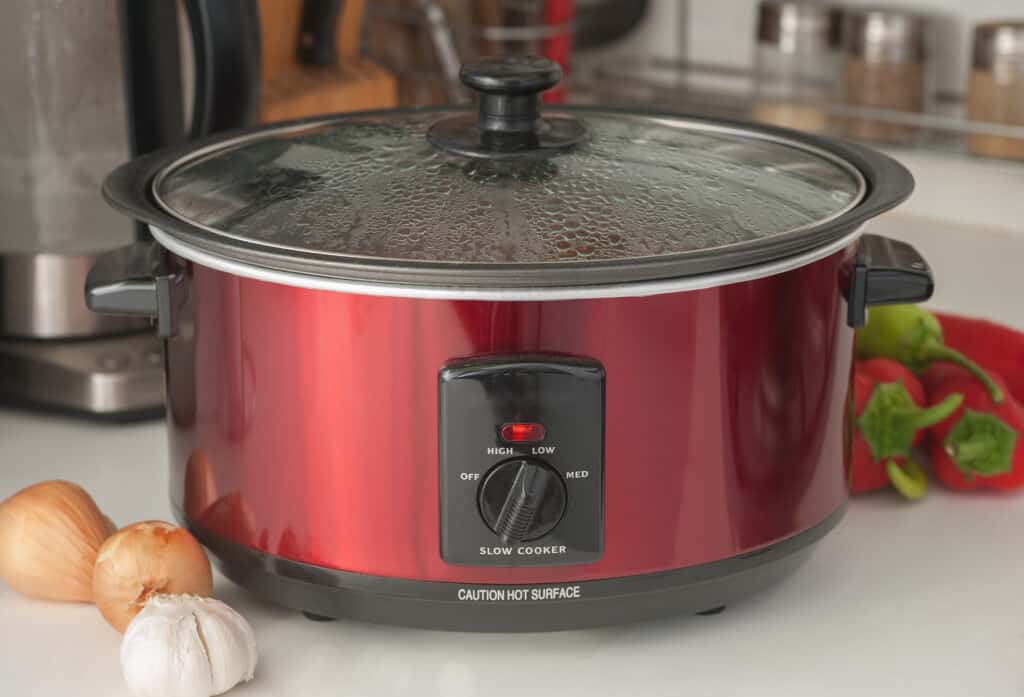As an avid slow cooker user, I’ve noticed that sometimes my slow cooker doesn’t bubble during the cooking process. This can cause concern for those who are unsure if their meal is cooking properly or if there’s a technical issue with the appliance.
In my experience, there are a few reasons why a slow cooker might not bubble, and understanding these factors can help determine whether there’s an issue with the slow cooker itself, the settings used, or if it’s simply a normal function of this type of kitchen tool.

Why Slow Cookers Don’t Always Bubble
In my experience, slow cookers may not always bubble, as they’re designed to cook at lower temperatures. The low and keep warm settings provide temperatures below the boiling point, which is why you might not notice any bubbling.
Furthermore, technical issues with your slow cooker‘s components might affect the bubbling. Issues such as a loose switch, broken thermal fuse, or heating element can cause temperature fluctuations, affecting the cooking process.
It’s also essential to consider the amount of liquid added to the slow cooker. Excess liquid can lead to excessive steam and condensation, diluting the cooked food rather than allowing it to bubble properly.
Lastly, the type of meat being cooked plays a role in how the slow cooker behaves. Leaner cuts are more likely to become dry and tough, whereas fattier cuts such as beef pot roast or pork shoulder roast are better suited for slow cooking, leading to the desired bubbling during the process.
Common Reasons for Slow Cookers Not Bubbling
The absence of bubbles in my slow cooker might be confusing, but it’s important to know that this can happen for a number of reasons, which I’ll explain in this section.
Low Temperature Settings
Firstly, low temperature settings might be the reason my slow cooker isn’t bubbling. Slow cookers are designed to cook food gently over a longer period, so low heat settings may not create visible bubbles.
If I’m worried about possible under-cooking, I can check the recipe and the cooker’s manual to ensure my temperature settings are correct for the dish I’m preparing.

Incorrect Lid Placement
Another possible cause is incorrect lid placement. By not positioning the lid correctly, heat may be escaping from the cooker, leading to a lack of bubbling.
To resolve this, I need to make sure the lid fits snugly on the slow cooker to retain heat, and ultimately promote bubbling.
Too Much or Too Little Liquid
Lastly, having too much or too little liquid in my slow cooker could affect bubbling as well. Excessive liquid might hinder bubbling, while too little liquid could lead to dry and overcooked food.
By referring to the recipe and adjusting the amount of liquid accordingly, I can ensure the proper conditions for my slow cooker to function effectively and produce the desired results.
Addressing the Issue
Let’s dive into solutions for common slow cooker issues and explore ways to achieve perfect bubbling.
Check Temperature Settings
I start by making sure my slow cooker is set to the right temperature level. I adjust the settings as needed, ensuring the heat is high enough for bubbling without burning the contents.
Ensure Proper Lid Placement
Another important factor is the lid placement. I check to see if my lid is fitting snugly, creating the necessary seal for heat retention and optimal bubbling.
Adjust Liquid Levels
Lastly, I consider the amount of liquid in my slow cooker. I adjust the liquid levels accordingly to prevent under or overcooking, keeping the contents bubbling gently throughout the cooking process.
When to Seek Professional Help
If I notice my slow cooker is not bubbling and suspect faulty components, such as a loose switch, broken thermal fuse, or malfunctioning heating element, it’s crucial to seek professional help.
Trying to fix the issue by myself could potentially pose safety hazards or cause further damage to the slow cooker.
Sometimes, manufacturers offer warranty support, which may cover repair costs or provide a replacement unit.
It’s a good idea to have the slow cooker model number and purchase date ready before contacting the manufacturer or taking it to an electronics store for repair.
Remember that maintaining a regular cleaning routine and using the slow cooker according to operating instructions can help prevent common issues and extend the appliance’s life.

FAQ
Why is my slow cooker not bubbling?
Bubbling may not occur if it’s set on a low heat setting or in the “keep warm” mode, which keeps the temperature below boiling point.
Should my slow cooker bubble?
Slow cookers are not meant to bubble constantly, and it could indicate faulty components or overheating if they do.
What can I do if my slow cooker is not bubbling?
First, ensure you have set it on the correct heat setting for your recipe, and if issues persist, check for possible malfunctions as mentioned in the device’s manual.
How can I troubleshoot a malfunctioning slow cooker?
If you suspect your slow cooker has faulty components, contact the manufacturer or take it to an electronics store for repair.
Is it possible to cook my dish without bubbling?
Yes, slow cooking allows flavors to develop and tenderize meats without necessarily reaching a boiling point or constant bubbling.
Conclusion
Based on my findings, it’s important to note that slow cookers are not typically designed to bubble while cooking. If you’ve noticed bubbling in your device, there may be an issue with the unit, like overheating or a malfunctioning thermostat.
When using a slow cooker, remember to fill it with an appropriate amount of food to avoid overcooking or undercooking. Following manufacturer guidelines and using the correct temperature settings will help ensure your meal is cooked properly without any temperature fluctuations. A well-maintained and properly functioning slow cooker is crucial for successful cooking results.





